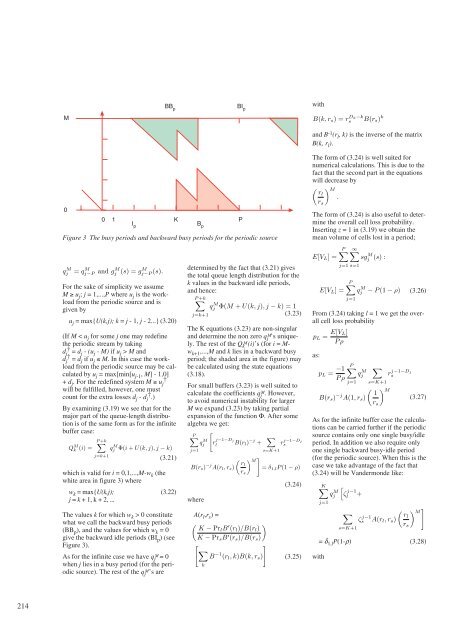Contents Telektronikk - Telenor
Contents Telektronikk - Telenor
Contents Telektronikk - Telenor
Create successful ePaper yourself
Turn your PDF publications into a flip-book with our unique Google optimized e-Paper software.
214<br />
M<br />
0<br />
0 1<br />
For the sake of simplicity we assume<br />
M ≥ uj ; j = 1,...,P where uj is the workload<br />
from the periodic source and is<br />
given by<br />
uj = max{U(k,j); k = j - 1, j - 2...} (3.20)<br />
(If M < uj for some j one may redefine<br />
the periodic stream by taking<br />
d †<br />
j = dj - (uj - M) if uj > M and<br />
d †<br />
j = dj if uj ≤ M. In this case the workload<br />
from the periodic source may be calculated<br />
by uj = max[min[uj-1 , M] - 1,0]<br />
+ dj . For the redefined system M ≥ u †<br />
j<br />
will be fulfilled, however, one must<br />
count for the extra losses dj - d †<br />
j .)<br />
By examining (3.19) we see that for the<br />
major part of the queue-length distribution<br />
is of the same form as for the infinite<br />
buffer case:<br />
(3.21)<br />
which is valid for i = 0,1,...,M-wk (the<br />
white area in figure 3) where<br />
wk = max{U(k,j); (3.22)<br />
j = k + 1, k + 2, ...<br />
The values k for which wk > 0 constitute<br />
what we call the backward busy periods<br />
(BBp ), and the values for which wk = 0<br />
give the backward idle periods (BIp ) (see<br />
Figure 3).<br />
As for the infinite case we have q M<br />
j = 0<br />
when j lies in a busy period (for the periodic<br />
source). The rest of the q M’s j are<br />
I p<br />
BB p<br />
K P<br />
B p<br />
Figure 3 The busy periods and backward busy periods for the periodic source<br />
q M j = q M j−P and g M j (s) =g M j−P (s).<br />
Q M k (i) =<br />
P �+k<br />
j=k+1<br />
q M j Φ(i + U(k, j),j− k)<br />
determined by the fact that (3.21) gives<br />
the total queue length distribution for the<br />
k values in the backward idle periods,<br />
and hence:<br />
P �+k<br />
q<br />
(3.23)<br />
M j Φ(M + U(k, j),j− k) =1<br />
j=k+1<br />
The K equations (3.23) are non-singular<br />
and determine the non zero q M’s j uniquely.<br />
The rest of the Q M(i)’s k (for i = Mwk+1<br />
,...,M and k lies in a backward busy<br />
period; the shaded area in the figure) may<br />
be calculated using the state equations<br />
(3.18).<br />
For small buffers (3.23) is well suited to<br />
calculate the coefficients qM. j However,<br />
to avoid numerical instability for larger<br />
M we expand (3.23) by taking partial<br />
expansion of the function Φ. After some<br />
algebra we get:<br />
P�<br />
j=1<br />
q M j<br />
where<br />
�<br />
B(rs) −j A(rl,rs)<br />
BI p<br />
A(rl ,rs ) =<br />
�<br />
K − PrlB ′ (rl)/B(rl)<br />
K − PrsB ′ �<br />
(rs)/B(rs)<br />
�<br />
�<br />
B −1 �<br />
(rl,k)B(k, rs)<br />
k<br />
r j−1−Dj<br />
l B(rl) −j + �<br />
� rl<br />
rs<br />
s=K+1<br />
r j−1−Dj<br />
s<br />
� �<br />
M<br />
= δ1,lP (1 − ρ)<br />
(3.24)<br />
(3.25)<br />
with<br />
B(k, rs) =r Dk−k<br />
s B(rs) k<br />
and B -1 (r l , k) is the inverse of the matrix<br />
B(k, r l ).<br />
The form of (3.24) is well suited for<br />
numerical calculations. This is due to the<br />
fact that the second part in the equations<br />
will decrease by<br />
� �M rl<br />
.<br />
The form of (3.24) is also useful to determine<br />
the overall cell loss probability.<br />
Inserting z = 1 in (3.19) we obtain the<br />
mean volume of cells lost in a period;<br />
E[VL] =<br />
(3.26)<br />
From (3.24) taking l = 1 we get the overall<br />
cell loss probability<br />
as:<br />
rs<br />
(3.27)<br />
As for the infinite buffer case the calculations<br />
can be carried further if the periodic<br />
source contains only one single busy/idle<br />
period. In addition we also require only<br />
one single backward busy-idle period<br />
(for the periodic source). When this is the<br />
case we take advantage of the fact that<br />
(3.24) will be Vandermonde like:<br />
with<br />
E[VL] =<br />
pL = E[VL]<br />
Pρ<br />
pL = −1<br />
Pρ<br />
P� ∞�<br />
j=1 s=1<br />
sg M j (s) :<br />
P�<br />
q M j − P (1 − ρ)<br />
j=1<br />
P�<br />
j=1<br />
q M j<br />
�<br />
B(rs) −j �<br />
1<br />
A(1,rs)<br />
K�<br />
j=1<br />
q M j<br />
�<br />
ζ j−1<br />
l<br />
�<br />
s=K+1<br />
+<br />
r<br />
s=K+1<br />
j−1−Dj<br />
s<br />
�M rs<br />
ζ j−1<br />
�<br />
rl<br />
s A(rl,rs)<br />
rs<br />
� M �<br />
= δ 1,l P(1-ρ) (3.28)

















